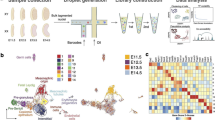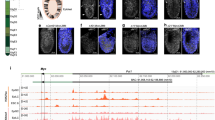Abstract
To address the biological function of RNA interference (RNAi)-related pathways in mammals, we disrupted the gene Dicer1 in mice. Loss of Dicer1 lead to lethality early in development, with Dicer1-null embryos depleted of stem cells. Coupled with our inability to generate viable Dicer1-null embryonic stem (ES) cells, this suggests a role for Dicer, and, by implication, the RNAi machinery, in maintaining the stem cell population during early mouse development.


Similar content being viewed by others
References
Hannon, G.J. Nature 418, 244–251 (2002).
Bernstein, E., Caudy, A.A., Hammond, S.M. & Hannon, G.J. Nature 409, 363–366 (2001).
Ketting, R.F. et al. Genes Dev. 15, 2654–2659 (2001).
Knight, S.W. & Bass, B.L. Science 293, 2269–2271 (2001).
Hutvagner, G. et al. Science 293, 834–838 (2001).
Grishok, A. et al. Cell 106, 23–34 (2001).
Hutvagner, G. & Zamore, P.D. Science 1, 1 (2002).
Zhang, P., Li, M.Z. & Elledge, S.J. Nat. Genet. 30, 31–39 (2002).
Blaszczyk, J. et al. Structure (Camb) 9, 1225–1236 (2001).
Carmell, M.A., Xuan, Z., Zhang, M.Q. & Hannon, G.J. Genes Dev. 16, 2733–2742 (2002).
Nichols, J. et al. Cell 95, 379–391 (1998).
Niwa, H., Masui, S., Chambers, I., Smith, A.G. & Miyazaki, J. Mol. Cell Biol. 22, 1526–1536 (2002).
Avilion, A.A. et al. Genes Dev. 17, 126–140 (2003).
Yeom, Y.I. et al. Development 122, 881–894 (1996).
Shauer, S.E., Jacobsen, S.E., Meinke, D.W. & Ray, A. Trends Plant Sci. 7, 487–491 (2002).
Acknowledgements
We thank L. Bianco and J. Coblentz for assistance with animals; B. Holdener, M.J. Garcia-Garcia and the Stony Brook University Histology Facility for help with initial embryo dissections; and M. Zhang and Z. Xuan for bioinformatics. E.M. is a Elisabeth Sloane Livingston Fellow of the Watson School of Biological Sciences. M.C. is supported by a US Army Breast Cancer Research Program Predoctoral Fellowship. This work was supported in part by grants from the US National Institutes of Health (G.J.H, S.J.E. and K.V.A) and the Howard Hughes Medical Institute (S.J.E.).
Author information
Authors and Affiliations
Corresponding author
Ethics declarations
Competing interests
The authors declare no competing financial interests.
Rights and permissions
About this article
Cite this article
Bernstein, E., Kim, S., Carmell, M. et al. Dicer is essential for mouse development. Nat Genet 35, 215–217 (2003). https://doi.org/10.1038/ng1253
Received:
Accepted:
Published:
Issue Date:
DOI: https://doi.org/10.1038/ng1253
- Springer Nature America, Inc.
This article is cited by
-
Base editing-mediated one-step inactivation of the Dnmt gene family reveals critical roles of DNA methylation during mouse gastrulation
Nature Communications (2023)
-
Congenital lung malformations
Nature Reviews Disease Primers (2023)
-
From a genome-wide screen of RNAi molecules against SARS-CoV-2 to a validated broad-spectrum and potent prophylaxis
Communications Biology (2023)
-
AGO2 silences mobile transposons in the nucleus of quiescent cells
Nature Structural & Molecular Biology (2023)
-
MicroRNA Profiling of Self-Renewing Human Neural Stem Cells Reveals Novel Sets of Differentially Expressed microRNAs During Neural Differentiation In Vitro
Stem Cell Reviews and Reports (2023)





